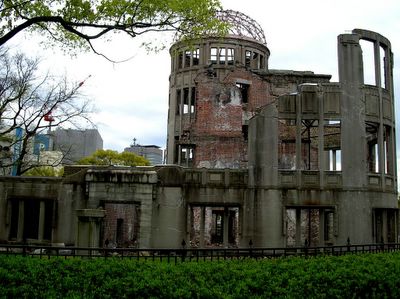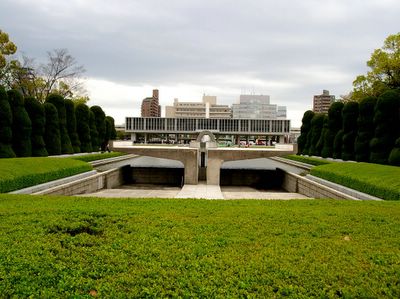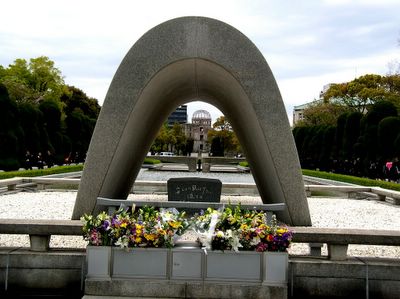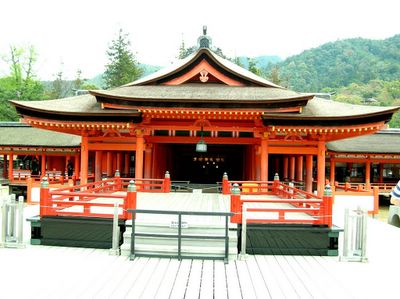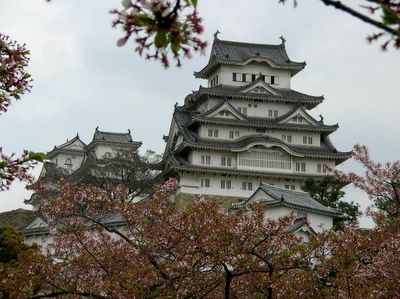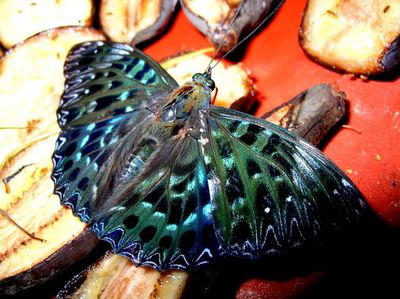 Nio-mon Gate (The main entrance to the Kiyomizudera)Kiyomizu-dera
Nio-mon Gate (The main entrance to the Kiyomizudera)Kiyomizu-dera (or
Kiyomizudera, 清水寺) means Pure Water Temple in english, is a temple located in Kyoto,Japan. It possess one of the best known sights of the Kyoto city.
 A city view from the Kiyomizudera
A city view from the Kiyomizudera
 Sakura flower in Kiyomizudera
Sakura flower in Kiyomizudera
According to the legend, the kiyomizu is a small temple which was established in 657 by monk Dosho from China.It is said that the Kiyomizu-dera (Pure Water Temple) was founded in 798 by the monk Enchin through the patronage of the warrior Tamuramaro.
 A view of Kiyomizudera
A view of KiyomizuderaTamuramaro at that time is a Grand General, Japan’s first military leader, came to this area for hunting deer. Those days, everyone believe that consuming deer blood had a good effect on easing childbirth, so Tamuramaro used to hunt deer for his wife. Enchin, however, condemned the general for killing animals, and Tamuramaro repented for his sin by building Kiyomizu-dera and dedicating it to Enchin the monk.
 A view of Kiyomizudera
A view of KiyomizuderaThere were several big fires over the centuries in Kiyomizu Temple, destroying almost all the buildings. In 1633, Tokugawa Iemitsu, a very famous shogun, restore most of the architecture and artwork of the temple.
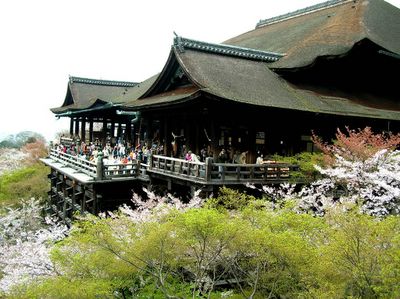 The famous Kiyomizudera Main Stage
The famous Kiyomizudera Main Stage
Kiyomizu Temple is famous for its very tall
Main Stage where it was constructed using 139 pillars and 90 crossbeams.The best part is that the whole temple is constructed without using any nails and can withstand a powerful earthquakes. It is said that those who survive from jumping down off the stage of Kiyomizu, their wish will be granted.
 The famous Kiyomizudera Main Stage
The famous Kiyomizudera Main StageOut of 234 jumps, 85.4 percent of them are survived,though the practice is now prohibited.
It is an UNESCO World Heritage Site and the Japanese government has designated it as Japan's Important Cultural Property and national treasures.
 The Otowa Waterfall
The Otowa WaterfallBeneath the main hall is the
waterfall Otowa-no-taki, where three channels of water drop into a pond. Each of the channel represent wisdom , longevity and matchmaking.Visitors to the temple normally will que up and drink the water, which is believed can have the therapeutic effect if drink in the metal cups.However, if we drink from all of the 3 channels,the good effects will be lost thus teach us not to be greedy.
 The Love Stone
The Love StoneThe temple complex contains several other shrines, notably
Jishu-jinja, decidated to Okuninushino-Mikoto, a god of love and "good matches". Jishu-jinja possesses a pair of "love stones" placed 18 metres apart, which lonely visitors attempt to walk between with their eyes closed. Success in reaching the other stone with the eyes closed, is taken as a presage that the pilgrim will find love.
 Make wish?Anyone interested?
Make wish?Anyone interested?One can be assisted in the crossing, where it will mean that an intermediary will be needed.
The complex also includes all the fixtures of a popular temple, being one of the most visited attractions of the city where there are some hawkers offering various talismans, incense, o-mikuji [御御籤, 御神籤, or おみくじ] (paper fortunes ranging from "great fortune" to "great ill") and ema [絵馬] (a small wooden plaque for writing prayers or wishes) abound.
 ema [絵馬] (a small wooden plaque for writing prayers or wishes)Koyasu Pagoda
ema [絵馬] (a small wooden plaque for writing prayers or wishes)Koyasu Pagoda is named after an image which it contains of the Koyasu Kannon. Koyasu means “an easy childbirth,” and it is said that if a pregnant woman can reach here, she can have her baby safely deliver.
 Koyasu PagodaZuigudo
Koyasu PagodaZuigudo, takes its name from its principal image of worship Daizuigu Bosatsu. Daizuigu Bosatsu is the mother of Buddha. Buddhism originated in India, and Sanskrit is an ancient Indian language that is the language of its classic literature. In this hall, there is nothing except for a stone on which is written the word “womb” in Sanskrit. We cannot see anything else because it is very, very dark. This reminds us of the womb of a mother. It is said that the Daizuigu Bosatsu can grant our wish, whatever it may be, so we make our wish here while circling the stone.
 Zuigudo
Zuigudotags :
Kyoto Kiyomizudera Pure Water Temple World Heritage Site 清水寺 Japanese National Cultural Treasure




















